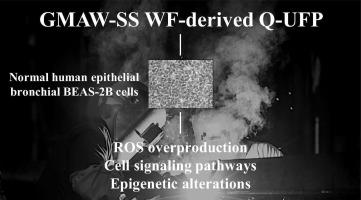NanoImpact ( IF 4.7 ) Pub Date : 2021-08-08 , DOI: 10.1016/j.impact.2021.100346 J Boudjema 1 , B Lima 2 , C Grare 2 , L Y Alleman 3 , D Rousset 4 , E Perdrix 3 , D Achour 2 , S Anthérieu 2 , A Platel 2 , F Nesslany 2 , A Leroyer 2 , C Nisse 2 , J-M Lo Guidice 2 , G Garçon 2

|
Recent evidence has supported welding fume (WF)-derived ultrafine particles (UFP) could be the driving force of their adverse health effects. However, UFP have not yet been extensively studied and are currently not included in present air quality standards/guidelines. Here, attention was focused on the underlying genetic and epigenetic mechanisms by which the quasi-UFP (Q-UFP, i.e., ≤ 0.25 μm) of the WF emitted by gas metal arc welding-stainless steel (GMAW-SS) exert their toxicity in human bronchial epithelial BEAS-2B cells. The Q-UFP under study showed a monomodal size distribution in number centered on 104.4 ± 52.3 nm and a zeta potential of −13.8 ± 0.3 mV. They were enriched in Fe > Cr > Mn > Si, and displayed a relatively high intrinsic oxidative potential. Dose-dependent activation of nuclear factor erythroid 2-related factor 2 and nuclear factor-kappa B signaling pathway, glutathione alteration, and DNA, protein and lipid oxidative damage were reported in BEAS-2B cells acutely (1.5 and 9 μg/cm2, 24 h) or repeatedly (0.25 and 1.5 μg/cm2, 3 × 24 h) exposed to Q-UFP (p < 0.05). Alterations of the Histone H3 acetylation were reported for any exposure (p < 0.05). Differentially regulated miRNA and mRNA indicated the activation of some critical cell signaling pathways related to oxidative stress, inflammation, and cell cycle deregulation towards apoptosis. Taken together, these results highlighted the urgent need to better evaluate the respective toxicity of the different metals and to include the Q-UFP fraction of WF in current air quality standards/guidelines relevant to the occupational settings.
中文翻译:

来自不锈钢气体保护金属电弧焊的富含金属的准超细颗粒诱导 BEAS-2B 细胞的遗传和表观遗传改变
最近的证据支持焊接烟雾 (WF) 衍生的超细颗粒 (UFP) 可能是其不利健康影响的驱动力。然而,UFP 尚未得到广泛研究,目前未包含在当前的空气质量标准/指南中。在这里,注意力集中在由气体保护金属电弧焊-不锈钢(GMAW-SS)释放的WF的准UFP(Q-UFP,即≤0.25μm)发挥其毒性的潜在遗传和表观遗传机制。人支气管上皮 BEAS-2B 细胞。研究中的 Q-UFP 显示出以 104.4 ± 52.3 nm 为中心的单峰尺寸分布和 -13.8 ± 0.3 mV 的 zeta 电位。它们富含 Fe > Cr > Mn > Si,并显示出相对较高的内在氧化电位。2 , 24 h) 或反复 (0.25 和 1.5 μg/cm 2 , 3 × 24 h) 暴露于 Q-UFP ( p < 0.05)。任何暴露都报告了组蛋白 H3 乙酰化的改变 (p < 0.05)。差异调节的 miRNA 和 mRNA 表明了一些与氧化应激、炎症和细胞周期失调相关的关键细胞信号通路向凋亡的激活。总而言之,这些结果强调了迫切需要更好地评估不同金属的各自毒性,并将 WF 的 Q-UFP 分数纳入与职业环境相关的当前空气质量标准/指南中。











































 京公网安备 11010802027423号
京公网安备 11010802027423号